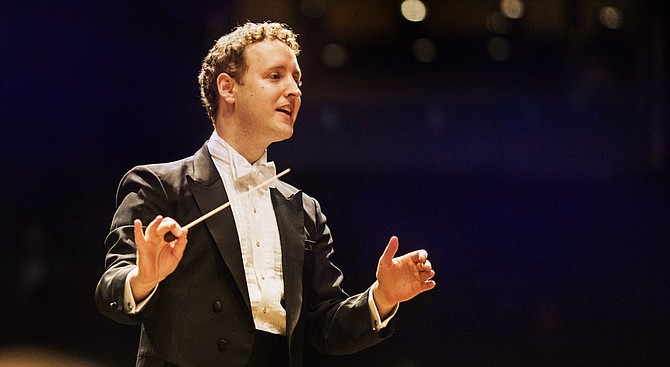 Facebook
Facebook
 X
X
 Instagram
Instagram
 TikTok
TikTok
 Youtube
Youtube

On Saturday, June 8, The Mainly Mozart Festival Orchestra exploded into the Balboa Theatre with a performance of Handel’s Royal Fireworks Music, thereby opening their five-concert series with music director Michael Francis. Full disclosure: I am an employee of Mainly Mozart.
After several conversations with musical snobs I call friends, we concluded it would be near impossible to improve upon the performance of all three pieces on the program.

The only objection was that the Royal Fireworks could have been more effective on period instruments.
The rebuttal would be that the style of the performance was of the period, so far as that can be determined. The rhythmical integrity of the performance would have made Christopher Hogwood proud.
Hard on the heels of Handel was Mozart. The Mainly Mozart Festival is in year four of a six-year journey through Mozart’s life as a composer and personality. This fourth year is all about Mozart’s first golden days in Vienna. It was during this time that Mozart became aware of Handel’s music via the salon concerts of Baron von Suiten. In 1782 Mozart wrote to his father that he spent every Sunday playing Bach and Handel with von Suiten.
Following the Royal Fireworks was Mozart’s Piano Concerto No. 21. The pianist on this occasion was McArthur Genius Grant recipient Jeremy Denk. Denk is no stranger to San Diego audiences. To anyone who attended, his concert of Bach’s Goldberg Variations remains a peak experience of the solo piano repertoire in this city.
It could be argued that the tempo of the opening and concluding movements of the concerto would line up with period-performance practices. Denk was quick but did not hurry. His playing was mercurial but this quicksilver was not willy nilly.
While the piano was being brought into place, Maestro Michael Francis explained that the tone of this concerto is in the vein of opera buffa. One year later Mozart would generate the greatest opera buffa of them all, The Marriage of Figaro.
The final piece was Mendelssohn’s Symphony No. 5: Reformation. This piece was the second symphony Mendelssohn composed, but he suppressed it during his lifetime. It was, therefore, the fifth symphony printed thereby giving it the aura of a later composition. It was composed in 1830 when Mendelssohn was 21 years old. It had its premiere in 1832 and was not published until 1868, 21 years after Mendelssohn had died.
The audacity of the young Mendelssohn is impressive. At the age of 21, he tried to integrate the Catholic, Lutheran, and Hebrew traditions. The opening bars quote Palestrina followed by a quotation of the Dresden Amen while the third movement refers to the tones of a Hebrew prayer before the final movement erects Luther’s A Mighty Fortress is our God.
The Mainly Mozart Festival runs through June 22.


On Saturday, June 8, The Mainly Mozart Festival Orchestra exploded into the Balboa Theatre with a performance of Handel’s Royal Fireworks Music, thereby opening their five-concert series with music director Michael Francis. Full disclosure: I am an employee of Mainly Mozart.
After several conversations with musical snobs I call friends, we concluded it would be near impossible to improve upon the performance of all three pieces on the program.

The only objection was that the Royal Fireworks could have been more effective on period instruments.
The rebuttal would be that the style of the performance was of the period, so far as that can be determined. The rhythmical integrity of the performance would have made Christopher Hogwood proud.
Hard on the heels of Handel was Mozart. The Mainly Mozart Festival is in year four of a six-year journey through Mozart’s life as a composer and personality. This fourth year is all about Mozart’s first golden days in Vienna. It was during this time that Mozart became aware of Handel’s music via the salon concerts of Baron von Suiten. In 1782 Mozart wrote to his father that he spent every Sunday playing Bach and Handel with von Suiten.
Following the Royal Fireworks was Mozart’s Piano Concerto No. 21. The pianist on this occasion was McArthur Genius Grant recipient Jeremy Denk. Denk is no stranger to San Diego audiences. To anyone who attended, his concert of Bach’s Goldberg Variations remains a peak experience of the solo piano repertoire in this city.
It could be argued that the tempo of the opening and concluding movements of the concerto would line up with period-performance practices. Denk was quick but did not hurry. His playing was mercurial but this quicksilver was not willy nilly.
While the piano was being brought into place, Maestro Michael Francis explained that the tone of this concerto is in the vein of opera buffa. One year later Mozart would generate the greatest opera buffa of them all, The Marriage of Figaro.
The final piece was Mendelssohn’s Symphony No. 5: Reformation. This piece was the second symphony Mendelssohn composed, but he suppressed it during his lifetime. It was, therefore, the fifth symphony printed thereby giving it the aura of a later composition. It was composed in 1830 when Mendelssohn was 21 years old. It had its premiere in 1832 and was not published until 1868, 21 years after Mendelssohn had died.
The audacity of the young Mendelssohn is impressive. At the age of 21, he tried to integrate the Catholic, Lutheran, and Hebrew traditions. The opening bars quote Palestrina followed by a quotation of the Dresden Amen while the third movement refers to the tones of a Hebrew prayer before the final movement erects Luther’s A Mighty Fortress is our God.
The Mainly Mozart Festival runs through June 22.
Comments